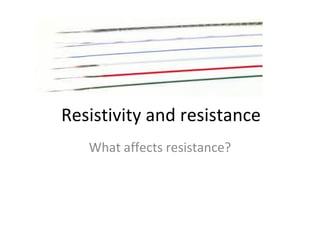
Resistivity and resistance.ppt
- 1. Resistivity and resistance What affects resistance?
- 3. What affects resistance The electrons (charge carriers) want to get through this straight wire, The atoms vibrate as they are at room temperature What shape would we want the resistor to allow the electrons to go through
- 4. Conductive putty experiment Caution putty is carcinogenic - use gloves It also gets everywhere – do it on top of newspaper What shape of putty has the lowest resistance
- 5. Resistivity Resistivity is a property of the material It is how well the material conducts electricity This formula shows that the resistance will increase if p increases or the length increases. The resistance will decrease if the area increases Ω m
- 6. Quick questions 1) Calculate the resistance of a uniform wire of diameter 0.32 mm and length 5.0m The resistivity of the wire = 5.0 x 10 -7 Ω m 2) Calculate the resistance of a rectangle strip of copper length 0.08m, thickness 15 mm and width 0.80mm The resistivity of copper= 1.7 x 10 -8 Ω m 3) A wire of uniform diameter 0.28 mm and length 1.50m has a resistance of 45 Ω Calculate a)Its resistivity b) The length of wire that has the resistance of 1.0 Ω A = pi r 2 These questions are tricky
- 7. Answers 1) Calculate the resistance of a uniform wire of diameter 0.32 mm and length 5.0m The resistivity of the wire = 5.0 x 10 -7 Ω m R= 5.0 x 10 -7 x 5/ (pi x 0.0016 2 ) 5/(pi x 0.00000256) 5/8x10 -6 625000 R= 31 Ω A = pi r 2 2) Calculate the resistance of a rectangle strip of copper length 0.08m, thickness 15 mm and width 0.80mm The resistivity of copper= 1.7 x 10 -8 Ω m Area = 0.015 x 0.0080 A = 0.00012 L = 0.08m R = 1.7 x 10 -8 x 0.08 / 0.00012 R = 0.0000113 R = 11 µ Ω 0.08m 0.80mm 15mm r = 0.0016
- 8. Answer question 3 3) A wire of uniform diameter 0.28 mm and length 1.50m has a resistance of 45 Ω Calculate a)Its resistivity b) The length of wire that has the resistance of 1.0 Ω A = pi r 2 r = 0.14 mm r= 0.00014m L = 1.50m R = 45 Ω A = 6.15 x 10 -8 =45 * (6.15 x 10 -8 / 1.5) = 0.0000018 =1.8x10 -6 Ω m
- 9. Thermistor A thermistor changes resistance when the temperature changes A resistor’s resistance will go down with temperature as the vibrating atoms (phonons) move less meaning there are less collisions with the electrons and it is easier for them to move through Is a thermistor the same?
- 10. Measure the resistance of the thermistor at 3 temperatures Ice water 0 degrees Celsius Room temperature ? Thermometor Boiling water 100 degrees Celcius Create a voltage - current graph for all the three situations Voltage Current The gradient is the resistance Calibrate the thermistor so you could use it to measure temperature V = IR
- 11. Semiconductor Thermistor at T = 0K Full of electrons Full of holes (free space for electrons) Thermistor above absolute zero energy At the hotter temperature electrons can get into the conducting band
- 12. Superconductors Some special material can become superconductors The superconductor has to be cooled down to its critical temperature (Tc) At the critical temperature the resistance fall to zero These can be used to make low loss power lines and very good electromagnets Resistance Temperature (k) 0 Tc The world record Tc of 138 K